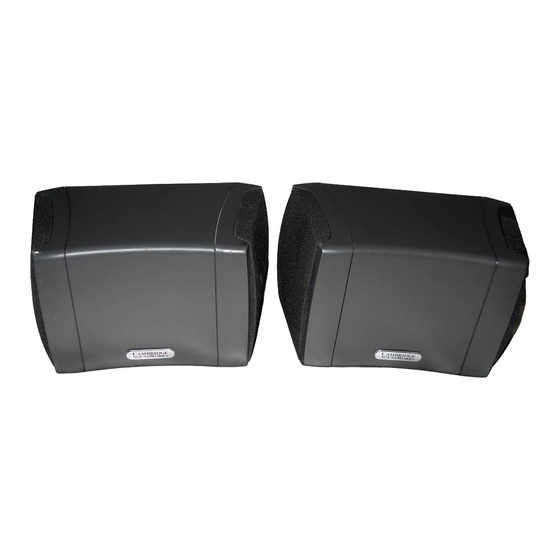
Table of Contents
Advertisement
Quick Links
Advertisement
Table of Contents

Summary of Contents for Cambridge SoundWorks NEWTON s100 Multipole
- Page 1 ™ S100 MultiPole Surround Speakers ™ User Manual ®...
-
Page 3: After Unpacking
Examine the speaker system carefully for shipping damage. If there is any, do not install or use the sys- tem. Return the speaker to the store where you made the purchase or call Cambridge SoundWorks at 1-800 FOR-HIFI (1-800-367-4434) for assistance. -
Page 4: Positioning Your Speakers
Don’t be too concerned if your situation and listening environment dictate the speakers’ position. As long as each surround speaker is on the left or right half of the listening space, the speakers are will provide convincing, lifelike sound. -
Page 5: Speaker Mounting
Hang the S100 directly on a wall: Install a No.10 screw in the wall so that its screwhead protrudes about 3/8 inch. Cambridge SoundWorks supplies screws and plastic anchors for your conven- ience, but it is the installer’s responsibility to insure the screw is securely mounted. - Page 6 MultiPole switch, in the pattern shown. Using The Speakers On A Stand Cambridge SoundWorks Model ST300 floor-stands may be used for the S100. The speakers mount to the stand with the MultiPole switch on top. For this reason, the positions of the speaker should be reversed (the speaker marked left should be placed on the listener’s right side and...
- Page 7 In Dipole mode, a listener can be closer to one surround speaker than the other and still hear both surround speakers. This characteristic makes it ideal for smaller rooms, where a listener may be closer to one surround speaker than the other.
- Page 8 PREPARE THE SPEAKER WIRE Use at least 18 gauge speaker cable for short runs (under 15 feet). Use 16 gauge or heavier speaker cable for longer runs. 1. Determine how long the speaker cable should be for each speaker. Cut the speaker cable into the appropriate lengths.
-
Page 9: Specifications
Distortion dramatically increases the internal operating temperature of a loudspeaker and will even- tually cause the speaker’s failure due to burned or melted internal parts. While Cambridge SoundWorks includes the most heat-tolerant parts commensurate with good acoustic design, the speaker’s Limited... - Page 10 10 10...
- Page 12 P81-2050 Rev A...













Need help?
Do you have a question about the NEWTON s100 Multipole and is the answer not in the manual?
Questions and answers